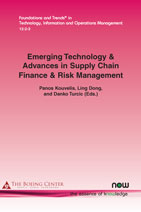Financing Suppliers under Performance Risk
By Christopher S. Tang, Anderson School of Management, UCLA, USA, chris.tang@anderson.ucla.edu | S. Alex Yang, University of Hong Kong, Hong Kong, sayang@hku.hk | Jing Wu, City University of Hong Kong, Hong Kong, jing.wu@cityu.edu.hk
Abstract
This chapter focuses on the relative efficiency of two innovation pre-shipment financing schemes that enable suppliers to obtain financing for production: purchase order financing (POF, under which financial institutions offer loans to suppliers by considering the value of purchase orders) and buyer direct financing (BDF, under which manufacturers lend directly to suppliers). Both schemes are closely related to suppliers’ performance risk (whether the supplier can deliver the order successfully). When the manufacturer and the bank have symmetric information regarding the supplier’s operational capabilitiy, we find that even though POF and BDF yield the same payoffs, BDF allows more flexibility in contract terms. However, when the manufacturer has superior information, BDF leads to higher payoffs when the supplier is severely financially constrained. The relative benefit of BDF is more pronounced when the supply market contains a larger fraction of inefficient suppliers, when efficiency gaps between suppliers are greater, or when the manufacturer’s alternative sourcing option is more expensive.
Emerging Technology & Advances in Supply Chain Finance & Risk Management
Emerging Technology & Advances in Supply Chain Finance & Risk Management reflects the state-of-the-art in research thought leadership in supply chain finance and risk management, and it contains great expository pieces on how advanced technologies are shaping supply chains and risk management within them. You will also find ideas on how supply chain finance and risk management can be best taught in our classrooms.
The volume is divided into three parts, each part reflecting a major active research area of the field including: Part 1: Supply Chain Finance; Part 2: Financial Hedging and Commodity Risks; Part 3: Operational Strategies and Risk Management.
Part 1 deals with the broad area of supply chain finance and programs that will better allow for working capital management within supply chains. Part 2 introduces concepts of hedging financial and operational risks due to uncertain commodity prices, fluctuating exchange rates, and volatile interest rates. Emphasis is placed on understanding how financial hedges can be used for hedging relevant supply chain risks in a way that reflects modern view of financial risk management. Part 3 examines topics and solution approaches reflecting the more traditional treatments in the contemporary literature of operational and supply chain risks. This volume provides rich implications for future research directions in efforts to master the new complexities and uncertainties of the global business environment and better understand the impact of advanced technologies in global supply chains.

Companion
Foundations and Trends® in Technology, Information and Operations Management, Volume 12, Issue 2-3 Special Issue: Emerging Technology & Advances in Supply Chain Finance & Risk Management
See the other articles that are also part of this special issue.